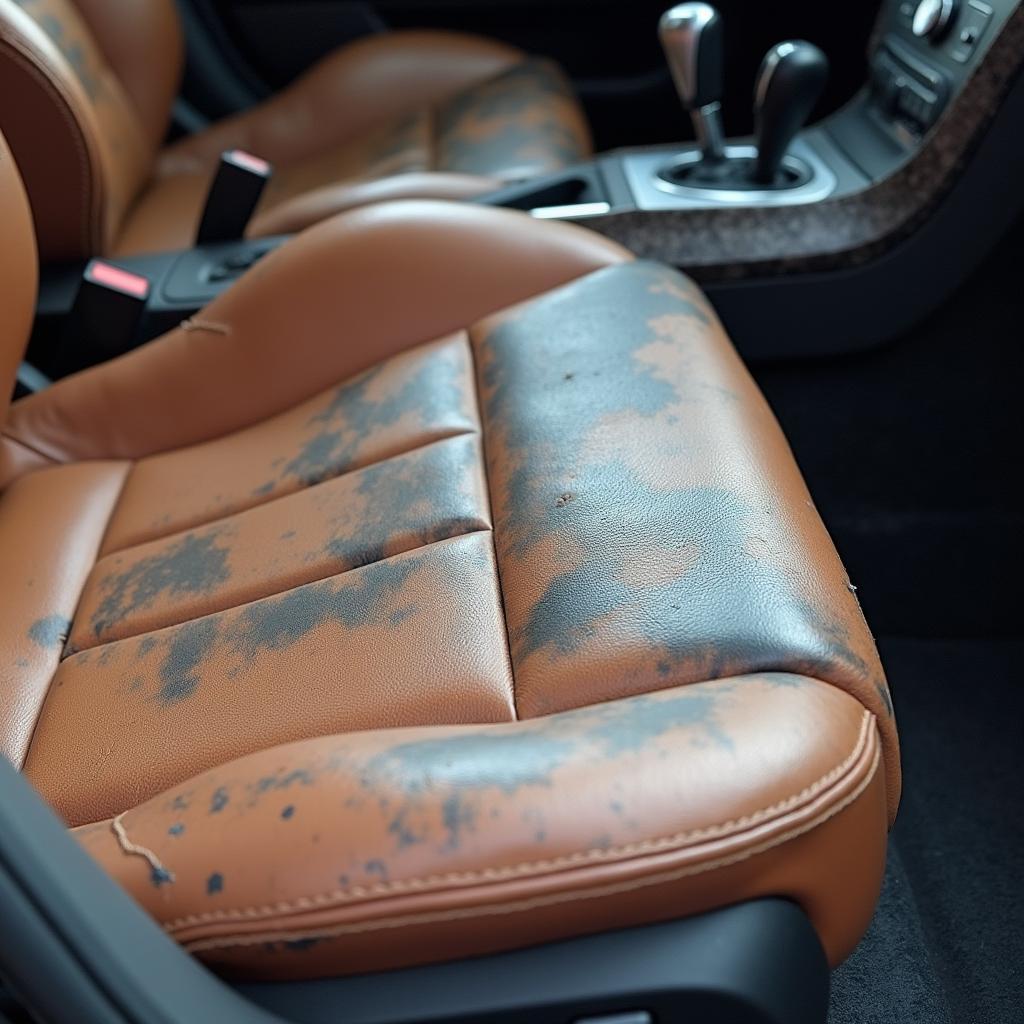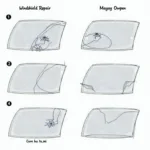Leather car seats undoubtedly add a touch of luxury to any vehicle’s interior. However, over time, exposure to sunlight, heat, and regular wear and tear can cause leather to fade, crack, and lose its supple feel. While this might seem like a major setback, the good news is that you can often revitalize your car’s leather seats yourself with a few simple steps and the right products. This comprehensive guide will walk you through everything you need to know about how to repair faded leather car seats and restore their former glory.
Understanding the Causes of Faded Leather Car Seats
Before diving into the repair process, it’s essential to understand the culprits behind faded leather. The most common factors include:
- UV Radiation: Prolonged exposure to the sun’s harmful ultraviolet (UV) rays is a primary cause of leather fading.
- Heat: Excessive heat, like that inside a parked car on a hot day, can dry out the leather, leading to fading and cracking.
- Friction and Abrasion: Regular rubbing against clothing, and getting in and out of the car can wear down the leather’s protective finish, making it more susceptible to fading.
- Improper Cleaning: Using harsh chemicals or abrasive cleaners can strip the leather of its natural oils, accelerating the fading process.
Gather Your Leather Seat Repair Supplies
To tackle this DIY project, you’ll need a few essential supplies:
- Gentle Leather Cleaner: Opt for a pH-neutral cleaner specifically designed for automotive leather.
- Leather Conditioner: This will help moisturize and restore the leather’s suppleness.
- Leather Dye (if necessary): Choose a high-quality leather dye that closely matches the original color of your car seats.
- Soft Cleaning Cloths: Microfiber cloths are ideal as they are gentle and won’t scratch the leather.
- Applicators (for dye and conditioner): Sponges, brushes, or spray bottles can be used depending on the product you choose.
- Masking Tape and Plastic Sheeting: These will protect surrounding areas if you’re using dye.
- Gloves and Protective Gear: Wear gloves to protect your hands and consider a mask when working with dyes.
A Step-by-Step Guide to Repairing Faded Leather Car Seats
Once you’ve assembled your materials, follow these steps to restore your leather car seats:
- Prepare Your Workspace: Choose a well-ventilated area and cover any surfaces you want to protect from spills or dye overspray.
- Clean the Leather Thoroughly: Using your chosen leather cleaner and a soft cloth, gently clean the entire surface of the seats. Pay extra attention to crevices and seams where dirt and grime accumulate.
- Allow the Seats to Dry Completely: Before proceeding to the next step, ensure the leather is completely dry. This will ensure optimal dye and conditioner absorption.
- Assess the Damage: After cleaning, you’ll have a clearer picture of the fading. Determine if a simple conditioning treatment is sufficient, or if you’ll need to use leather dye for a more significant color restoration.
Repairing Lightly Faded Leather
If the fading is minimal, a good leather conditioner might be all you need:
- Apply Leather Conditioner: Apply the leather conditioner evenly to the seats using a soft cloth or applicator. Follow the product instructions for the recommended amount and application technique.
- Let the Conditioner Soak In: Allow the conditioner to penetrate the leather for the time specified on the product label. This could range from a few minutes to a few hours.
- Buff the Seats: Once the conditioner has soaked in, use a clean, dry cloth to buff the seats gently. This will remove any excess conditioner and leave a smooth, revitalized finish.
Addressing Severely Faded Leather
For more severe fading, leather dye is the way to go:
- Mask Off Surrounding Areas: Using masking tape and plastic sheeting, carefully protect any areas you don’t want to get dye on, such as the dashboard, center console, and carpet.
- Apply Leather Dye: Following the dye manufacturer’s instructions, apply the dye evenly to the seats using a sponge, brush, or spray bottle. Multiple thin coats are usually better than one thick coat for a more even and natural-looking finish.
- Allow Each Coat to Dry: Let each coat of dye dry completely before applying the next. This drying time can vary depending on the type of dye used.
- Apply Leather Conditioner (Optional): Some leather dyes may have conditioning properties. If not, apply a leather conditioner after the final coat of dye has dried completely. This will help maintain the leather’s moisture and prevent future fading.
Tips for Maintaining Your Revitalized Leather Car Seats
Once you’ve successfully restored your leather car seats, follow these tips to keep them looking their best:
- Regular Cleaning: Clean your leather seats regularly (every 4-6 weeks) using a pH-neutral leather cleaner to remove dirt and grime.
- Conditioning is Key: Condition your leather seats every 3-4 months, or more often if you live in a hot or sunny climate, to keep the leather supple and prevent drying and cracking.
- UV Protection: Park your car in the shade or use a sunshade to protect your leather seats from harmful UV rays.
- Address Spills Promptly: Wipe up spills immediately to prevent them from staining the leather.
Conclusion
Learning how to repair faded leather car seats is a valuable skill that can save you money and maintain the pristine appearance of your vehicle’s interior. By following these steps and incorporating regular leather care into your routine, you can keep your car seats looking their best for years to come. Remember, consistent care is key to preserving the beauty and longevity of your leather car seats.
FAQs
Q: Can I use household cleaners on my leather car seats?
A: It’s not recommended to use household cleaners on leather car seats as they can be too harsh and strip the leather of its natural oils, leading to drying, cracking, and even discoloration.
Q: How often should I condition my leather car seats?
A: It’s generally recommended to condition leather car seats every 3-4 months. However, if you live in a hot or sunny climate, or if your car is frequently exposed to the elements, you may need to condition them more often.
Q: Can I repair scratches on my leather car seats using the same methods?
A: While the methods outlined above can help improve the appearance of minor scratches, deep scratches may require professional repair.
Need assistance with a more complex car leather seat repair? Contact us via WhatsApp at +1(641)206-8880 or email us at [email protected]. We offer 24/7 customer support and are happy to answer any questions you may have. For guidance on repairing worn leather car seats, check out our comprehensive guide: how to repair worn leather seats in car.



